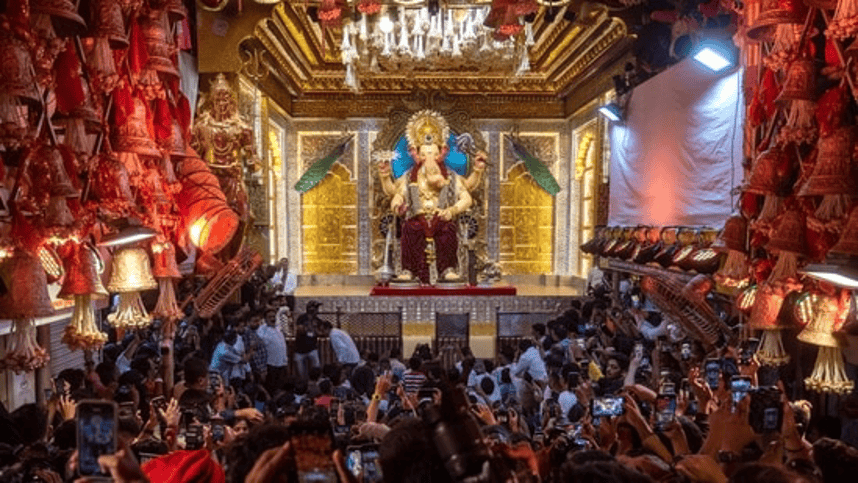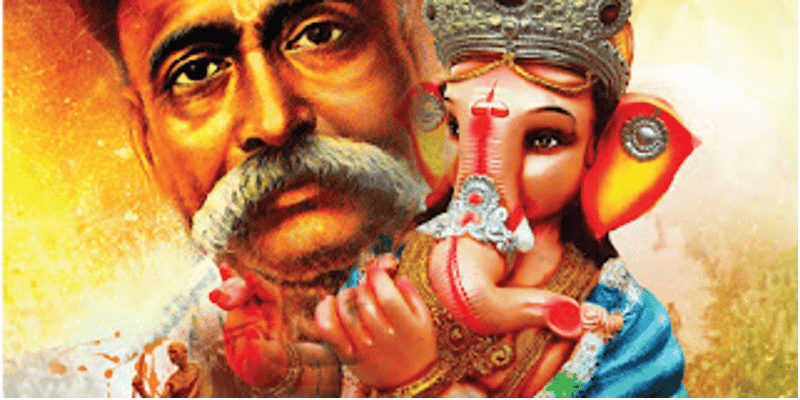
Bal Gangadhar Tilak; born Keshav Gangadhar Tilak (23 July 1856- 1 August 1920), endeared as Lokamānya Tilak, was an Indian nationalist, teacher and an independence activist. He was one of the ‘Lal Bal Pal’ triumvirate. The Indian Rebellion of 1857, was a rebellion that posed a serious threat to the rule of East India company. Bal Gangadhar Tilak was one of the prominent leaders, who transformed the household worshipping of Ganpati into a grand public event (Sarvajanik Ganeshotsav) during this period.
The festival’s name indicates its time of celebration: it starts on the fourth day (Chaturthi) of the bright half of the sixth solar month of the Hindu calendar, referred to as Bhadrapada. Some historians are of the opinion that the earliest instances of Ganesh Chaturthi celebrations can be traced back to the times when Satavahana, Rashtrakuta and Chalukya dynasties reigned (271 BC-1190 AD). However, with the initiative of Lokmanya Tilak, it turned into a platform for grand cultural activity for cultural awakening and national integrity.

It was openly held in Pune since the reign of Shivaji Maharaj, who used Vedic tradition to promote culture and nationalism. Ganpati was revered as the Peshwas’ ‘Kuldaivat’(family deity), and the festival was celebrated with great pomp in Pune, particularly at the Shaniwar Wada. The practice persisted until 1818, when the last Peshwa, Baji Rao II was defeated by the English East India company in the Third Anglo-Maratha war, thereby ending the Peshwai and the magnificent celebration of Ganesh Chaturthi. However, it had persisted as part of private family gatherings in Maharashtra.

Later, during the colonial era, political resistance was prohibited by the British administration. They restricted public meetings, particularly political ones, for the concern that big crowds of Indians might spark major protests against colonial rule. The repression of political meetings hampered the development of a cohesive national movement. However, throughout the colonial era, the British largely avoided interfering with religious meetings owing to their desire to maintain social stability and prevent large scale disturbance by respecting local inhabitants’ firmly held religious convictions. They were also less concerned about religious gatherings, as they deemed them to be harmless cultural displays. Thus on 1st November 1858, Lord Canning announced Queen Victoria’s proclamation which unveiled a new British policy of perpetual support for “Native Princes” and non-intervention in matters of religious beliefs or worship within British India.
Tilak found a legal loophole to bypass this British law and subsequently revived the festival in 1893, by initiating it in the Pune Assembly as a symbol of cultural integration and a platform for not only religious devotion, but also political discourse. This was represented with the installation of Ganesha idols and community processions, supported with musical performances, speeches, songs and the sacred slogan: ‘Ganapati Bappā Moryā, Phudchya Varshi Lavkar Ya’ (‘O! Lord Ganesha, I praise you, please come back soon next year and Bless us’) wherein leaders could promote nationalist ideals, inspire the masses and challenge colonial oppression. In the second half of the 19th century, Indian autonomy was the priority and Tilak, M.K. Gandhi and Muhammed Ali Jinnah, jointly celebrated Ganesha Chaturthi in Mumbai.
This festival originating in Maharashtra has now become a pan-Indian festival which has expanded throughout India. Approximately even after 127 years of Lokmanya tilak initiating Ganesha Chaturthi, it has blossomed and become one of the most significant festivals. Despite all of the industrialisation, development and cultural adaptation, Ganesh Chaturthi has kept its historic splendour.
Prior to independence, only upper caste people, leaders, worshipped Lord Ganesh. However, Tilak regarded the festival as a method of boosting community engagement and bringing people from all castes together for 10-12 days in order to bridge the gap between the various segments of society and enhance the relationship between them. Through his leadership and vision, Ganesh Chaturthi became a national symbol of India’s struggle for independence helping to inspire a generation of freedom fighters and galvanize the masses against British rule. Lord Ganesha, the remover of obstacles, became a symbol of India’s collective will to achieve freedom and self-determination.

While the festival’s political focus has changed throughout time, it still represents the power of collective action and the social concerns ranging from environmental protection (represented by eco-friendly idols) to social justice movements. The spirit of solidarity that Tilak instilled in the festival lives on, and the teachings of leveraging culture and tradition to effect greater societal changes remain relevant. As India continues to face social and political issues, Ganesh Chaturthi serves as a reminder of how culture may act as a catalyst for change, bringing people together in the spirit of development and equality. In a world where divisions often seem insurmountable, the legacy of Lokmanya Tilak’s vision for Ganesh Chaturthi offers a powerful lesson in the potential for unity through tradition.

Tilak has quoted, “He who does what is beneficial to the people of this country, be he a Mohammedan or an Englishman, is not alien. ‘Alienness’ has to do with interests. Alienness is certainly not concerned with white or black skin . . . or religion.” This portrays his vision of Ganeshotsav as a medium for political awakening and social reform, which not only revitalized traditional festivals but also helped in nurturing a sense of pride and unity among Indians.
Written by Shruti Shiraguppi
Edited by Rajan Patel




